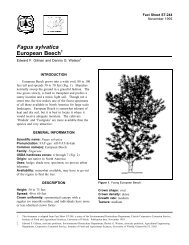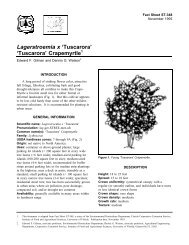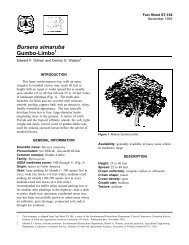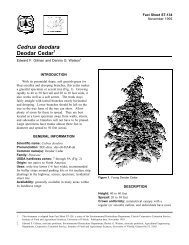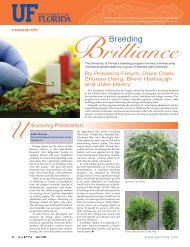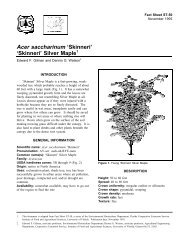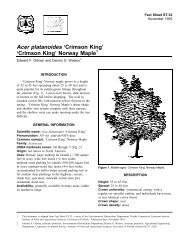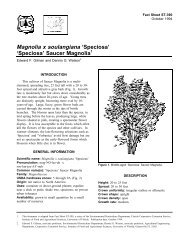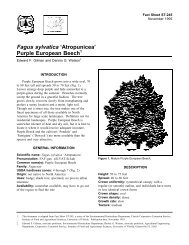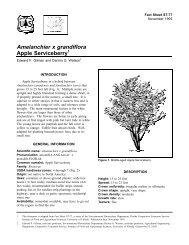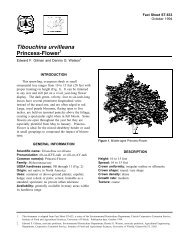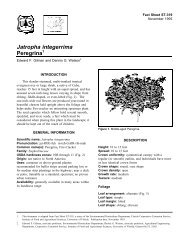Cercis canadensis var. alba White Eastern Redbud - Environmental ...
Cercis canadensis var. alba White Eastern Redbud - Environmental ...
Cercis canadensis var. alba White Eastern Redbud - Environmental ...
Create successful ePaper yourself
Turn your PDF publications into a flip-book with our unique Google optimized e-Paper software.
<strong>Cercis</strong> <strong>canadensis</strong> <strong>var</strong>. <strong>alba</strong><br />
<strong>White</strong> <strong>Eastern</strong> <strong>Redbud</strong> 1<br />
Edward F. Gilman and Dennis G. Watson 2<br />
INTRODUCTION<br />
The state tree of Oklahoma, <strong>Redbud</strong> is a moderate<br />
to rapid-grower when young, reaching a height of 20<br />
to 30 feet (Fig. 1). Thirty-year-old specimens are rare<br />
but they can reach 35 feet in height forming a rounded<br />
vase. The bright white flowers appear all over the tree<br />
in spring, just before the leaves emerge. <strong>Redbud</strong> has<br />
an irregular growth habit when young but forms a<br />
graceful flat-topped vase-shape or globe as it gets<br />
older. The tree usually branches low on the trunk, and<br />
if left intact forms a graceful multitrunked habit. Be<br />
sure to avoid weak forks by pruning to reduce the size<br />
of lateral branches. Keep them less than half the<br />
diameter of the main trunk to increase longevity of the<br />
tree. Do not allow multiple trunks to grow with tight<br />
crotches, instead space branches about 6 to 10 inches<br />
apart along a main trunk. Yellow (although somewhat<br />
<strong>var</strong>iable and unreliable) fall color and tolerance to<br />
partial shade make this a suitable, attractive tree for<br />
understory or specimen planting. Best not used<br />
extensively as a street tree due to low disease<br />
resistance and short life, but is nice in commercial and<br />
residential landscapes. Plant in a shrub border for a<br />
spring and fall color display.<br />
GENERAL INFORMATION<br />
Scientific name: <strong>Cercis</strong> <strong>canadensis</strong> <strong>var</strong>. <strong>alba</strong><br />
Pronunciation: SER-sis kan-uh-DEN-sis <strong>var</strong>iety<br />
AL-buh<br />
Common name(s): <strong>White</strong> <strong>Eastern</strong> <strong>Redbud</strong><br />
Family: Leguminosae<br />
USDA hardiness zones: 4B through 9A (Fig. 2)<br />
Origin: native to North America<br />
Figure 1. Mature <strong>White</strong> <strong>Eastern</strong> <strong>Redbud</strong>.<br />
Fact Sheet ST-149<br />
November 1993<br />
Uses: container or above-ground planter; large<br />
parking lot islands (> 200 square feet in size); wide<br />
tree lawns (>6 feet wide); medium-sized parking lot<br />
islands (100-200 square feet in size); medium-sized<br />
tree lawns (4-6 feet wide); recommended for buffer<br />
strips around parking lots or for median strip plantings<br />
in the highway; near a deck or patio; reclamation<br />
plant; shade tree; small parking lot islands (< 100<br />
square feet in size); narrow tree lawns (3-4 feet wide);<br />
specimen; sidewalk cutout (tree pit); residential street<br />
tree<br />
Availability: somewhat available, may have to go out<br />
of the region to find the tree<br />
1. This document is adapted from Fact Sheet ST-149, a series of the <strong>Environmental</strong> Horticulture Department, Florida Cooperative Extension Service,<br />
Institute of Food and Agricultural Sciences, University of Florida. Publication date: November 1993.<br />
2. Edward F. Gilman, associate professor, <strong>Environmental</strong> Horticulture Department; Dennis G. Watson, associate professor, Agricultural Engineering<br />
Department, Cooperative Extension Service, Institute of Food and Agricultural Sciences, University of Florida, Gainesville FL 32611.
<strong>Cercis</strong> <strong>canadensis</strong> <strong>var</strong>. <strong>alba</strong> -- <strong>White</strong> <strong>Eastern</strong> <strong>Redbud</strong> Page 2<br />
Figure 2. Shaded area represents potential planting range.<br />
DESCRIPTION<br />
Height: 20 to 30 feet<br />
Spread: 15 to 25 feet<br />
Crown uniformity: irregular outline or silhouette<br />
Crown shape: round; vase shape<br />
Crown density: moderate<br />
Growth rate: fast<br />
Texture: coarse<br />
Foliage<br />
Leaf arrangement: alternate (Fig. 3)<br />
Leaf type: simple<br />
Leaf margin: entire<br />
Leaf shape: orbiculate; ovate<br />
Leaf venation: banchidodrome; pinnate; palmate;<br />
reticulate<br />
Leaf type and persistence: deciduous<br />
Leaf blade length: 4 to 8 inches; 2 to 4 inches<br />
Leaf color: green<br />
Fall color: yellow<br />
Fall characteristic: showy<br />
Flower<br />
Flower color: white<br />
Flower characteristics: spring flowering; very<br />
showy<br />
Fruit<br />
Fruit shape: pod<br />
Fruit length: 1 to 3 inches<br />
Fruit covering: dry or hard<br />
Fruit color: brown<br />
Fruit characteristics: does not attract wildlife; no<br />
significant litter problem; persistent on the tree; showy<br />
Trunk and Branches<br />
Trunk/bark/branches: bark is thin and easily<br />
damaged from mechanical impact; droop as the tree<br />
grows, and will require pruning for vehicular or<br />
pedestrian clearance beneath the canopy; routinely<br />
grown with, or trainable to be grown with, multiple<br />
trunks; not particularly showy; tree wants to grow with<br />
several trunks but can be trained to grow with a single<br />
trunk; no thorns
<strong>Cercis</strong> <strong>canadensis</strong> <strong>var</strong>. <strong>alba</strong> -- <strong>White</strong> <strong>Eastern</strong> <strong>Redbud</strong> Page 3<br />
Figure 3. Foliage of <strong>White</strong> <strong>Eastern</strong> <strong>Redbud</strong>.<br />
Pruning requirement: requires pruning to develop<br />
strong structure<br />
Breakage: susceptible to breakage either at the crotch<br />
due to poor collar formation, or the wood itself is<br />
weak and tends to break<br />
Current year twig color: brown<br />
Current year twig thickness: medium<br />
Culture<br />
Light requirement: tree grows in part shade/part sun;<br />
tree grows in full sun<br />
Soil tolerances: clay; loam; sand; acidic; alkaline;<br />
well-drained<br />
Drought tolerance: high<br />
Aerosol salt tolerance: none<br />
Other<br />
Roots: surface roots are usually not a problem<br />
Winter interest: no special winter interest<br />
Outstanding tree: tree has outstanding ornamental<br />
features and could be planted more<br />
Invasive potential: little, if any, potential at this time<br />
Verticillium wilt susceptibility: susceptible<br />
Pest resistance: long-term health usually not<br />
affected by pests<br />
USE AND MANAGEMENT<br />
<strong>Redbud</strong>s grow well in full sun in the northern part<br />
of its range but will benefit from some shade in the<br />
southern zones, particularly in the lower mid-west<br />
where summers are hot. Best growth occurs in a light,<br />
rich, moist soil but <strong>Redbud</strong> adapts well to a <strong>var</strong>iety of<br />
soil including sandy or alkaline. Trees look better<br />
when they receive some irrigation in summer dry<br />
spells. Its native habitat ranges from stream bank to<br />
dry ridge, demonstrating its adaptability. Trees are<br />
sold as single or multistemmed. Young trees are<br />
easiest to transplant and survive best when planted in<br />
the spring or fall. Containerized trees can be planted<br />
anytime. The beans provide food for some birds.<br />
Trees are short-lived but provide a wonderful show in<br />
the spring and fall.<br />
Several culti<strong>var</strong>s of <strong>Redbud</strong> may be seen: ‘Pink<br />
Charm’ - flowers pink; ‘Pinkbud’ - flowers pink;<br />
‘Purple Leaf’ - young foliage purple; ‘Silver Cloud’ -<br />
leaves <strong>var</strong>iegated with white; ‘Flame’ - more erect<br />
branching, flowers double, blooms later, sterile so no<br />
seed pods form. ‘Forest Pansy’ is a particularly<br />
attractive culti<strong>var</strong> with purple-red leaves in the spring,<br />
but color fades to green in the summer in the south.<br />
<strong>Cercis</strong> <strong>canadensis</strong> <strong>var</strong>. texensis ‘Texas <strong>White</strong>’ and<br />
<strong>Cercis</strong> reniformis ‘Oklahoma’ have far superior foliage<br />
and make a wonderful substitute for the <strong>Eastern</strong><br />
<strong>Redbud</strong>, particularly in non-irrigated areas. These are<br />
also better for central and western Oklahoma and<br />
Texas.<br />
<strong>Cercis</strong> are best propagated by seed. Use ripe seed<br />
to plant directly, or, if seed has been stored,<br />
stratification is necessary before sowing in a<br />
greenhouse. Culti<strong>var</strong>s can be propagated by grafting<br />
onto seedlings, or by summer cuttings under mist or in<br />
a greenhouse.<br />
Pests<br />
Borers attack the trunk of older and stressed trees.<br />
Keep the plant vigorous.<br />
Scale insects can usually be controlled with<br />
horticultural sprays.<br />
Webworm can defoliate parts of the tree in<br />
summer and fall.
<strong>Cercis</strong> <strong>canadensis</strong> <strong>var</strong>. <strong>alba</strong> -- <strong>White</strong> <strong>Eastern</strong> <strong>Redbud</strong> Page 4<br />
Diseases<br />
Canker is the biggest problem with <strong>Redbud</strong>.<br />
Dieback begins as a canker on a branch. The cankers,<br />
at first small and sunken, enlarge to girdle the branch.<br />
Bark in the canker turns black and a crack forms<br />
between diseased and healthy bark. The fungus enters<br />
through wounds or dead and dying branches. Once<br />
girdled, the part of the stem beyond the canker wilts<br />
and dies. There is no chemical control. Prune out<br />
diseased branches.<br />
Leaf spots can be a problem during wet weather.<br />
Since the disease is rarely serious, no chemical<br />
controls are suggested.<br />
Verticillium wilt attacks and kills <strong>Redbud</strong>.<br />
Fertilize affected trees with nitrogen fertilizer and<br />
prune out wilted branches.



